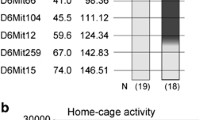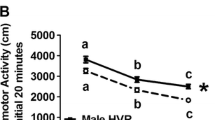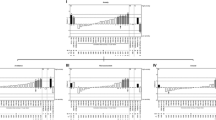Abstract
Genetic differences in ethanol's ability to induce conditioned place preference were studied in 20 BXD Recombinant Inbred (RI) mouse strains and in the C57BL/6J and DBA/2J progenitor strains. Male mice from each strain were exposed to a Pavlovian conditioning procedure in which a distinctive floor stimulus (CS+) was paired four times with ethanol (2 g/kg). A different floor stimulus (CS-) was paired with saline. Control mice were injected only with saline. Floor preference testing without ethanol revealed significant genetic differences in conditioned place preference, with some strains spending nearly 80% time on the ethanolpaired floor while others spent only 50% (i.e., no preference). Control mice showed genetic differences in unconditioned preference for the floor cues, but unconditioned preference was not genetically correlated with conditioned preference. There were also substantial genetic differences in ethanol-stimulated activity, but contrary to psychomotor stimulant theory, ethanol-induced activity on conditioning trials was not positively correlated with strength of conditioned place preference. However, there was a significant negative genetic correlation (r=−0.42) between test session activity and preference. Quantitative trait loci (QTL) analyses showed strong associations (P<0.01) between conditioned place preference and marker loci on chromosomes 4, 8, 9, 18 and 19. Weaker associations (0.01<P<0.05) were identified on several other chromosomes. Analysis also yielded several significant QTL for unconditioned preference, ethanol-stimulated activity, and sensitization. Overall, these data support the conclusion that genotype influences ethanol-induced conditioned place preference, presumably via genetic differences in sensitivity to ethanol's rewarding effects. Moreover, several chromosomal regions containing candidate genes of potential relevance to ethanol-induced conditioned place preference have been identified.
Similar content being viewed by others
References
Anderson SM, McClearn GE (1981) Ethanol consumption: selective breeding in mice. Behav Genet 11:291–301
Bailey DW (1981) Recombinant inbred strains and bilineal congenic strains. In: Foster HL, Small JD, Fox JG (eds) The mouse in biomedical research. Academic Press, New York, pp 223–239
Belknap JK (1992) Empirical estimates of Bonferroni corrections for use in chromosome mapping studies with BXD recombinant inbred strains. Behav Genet 22:677–684
Belknap JK, Belknap ND, Berg JH, Coleman R (1977) Pre-absorptive versus postabsorptive control of ethanol intake in C57BL/6J and DBA/2J mice. Behav Genet 7:413–425
Belknap JK, Coleman RR, Foster K (1978) Alcohol consumption and sensory threshold differences between C57BL/6J and DBA/2J mice. Physiol Psychol 6:71–74
Belknap JK, Crabbe JC, Young ER (1993a) Voluntary consumption of ethanol in 15 inbred mouse strains. Psychopharmacology 112:503–510
Belknap JK, Metten P, Helms ML, O'Toole LA, Angeli-Gade S, Crabbe JC, Phillips TJ (1993b) Quantitative trait loci (QTL) applications to substances of abuse: physical dependence studies with nitrous oxide and ethanol in BXD mice. Behav Genet 23:211–220
Cadoret RJ (1990) Genetics of alcoholism. In: Collins RL, Leonard KE, Searles JS (eds) Alcohol and the family: research and clinical perspectives. Guilford Press, New York, pp 39–78
Carr GD, Fibiger HC, Phillips AG (1989) Conditioned place preference as a measure of drug reward. In: Liebman JM, Cooper SJ (eds) Neuropharmacological basis of reward. Oxford, New York, pp 264–319
Copeland NG, Jenkins NA, Gilbert DJ, Eppig JT, Maltais LJ, Miller JC, Dietrich WF, Weaver A, Lincoln SE, Steen RG, Stein LD, Nadeau JH, Lander ES (1993) A genetic linkage map of the mouse: current applications and future prospects. Science 262:57–66
Crabbe JC (1983) Sensitivity to ethanol in inbred mice: genotypic correlations among several behavioral responses. Behav Neurosci 97:280–289
Crabbe JC, Janowsky JS, Young ER, Rigter H (1980) Strain-specific effects of ethanol on open field activity in inbred mice. Subst Alcohol Actions/Misuse 1:537–543
Crabbe JC, Johnson NA, Gray DK, Kosobud A, Young ER (1982a) Biphasic effects of ethanol on open-field activity: sensitivity and tolerance in C57BL/6N and DBA/2N mice. J Comp Physiol Psychol 96:440–451
Crabbe JC, Janowsky JS, Young ER, Kosobud A, Stack J, Rigter H (1982b) Tolerance to ethanol hypothermia in inbred mice: genotypic correlations with behavioral responses. Alcohol Clin Exp Res 6:446–458
Crabbe JC, Kosobud A, Young ER, Janowksy JS (1983) Polygenic and single-gene determination of responses to ethanol in BXD/Ty recombinant inbred strains. Neurobehav Toxicol Teratol 5:181–187
Crabbe JC, Young ER, Deutsch CM, Tam BR, Kosobud A (1987) Mice genetically selected for differences in open-field activity after ethanol. Pharmacol Biochem Behav 27:577–581
Crabbe JC, Phillips TJ, Kosobud A, Belknap JK (1990) Estimation of genetic correlation: interpretation of experiments using selectively bred and inbred animals. Alcohol Clin Exp Res 14:141–151
Crabbe JC, Phillips TJ, Cunningham CL, Belknap JK (1992) Genetic determinants of ethanol reinforcement. Ann NY Acad Sci 654:302–310
Crabbe JC, Belknap JK, Buck KJ (1994a) Genetic animal models of alcohol and drug abuse. Science 264:1715–1723
Crabbe JC, Gallaher ES, Phillips TJ, Belknap JK (1994b) Genetic determinants of sensitivity to ethanol in inbred mice. Behav Neurosci 108:186–195
Cunningham CL (1993) Pavlovian drug conditioning. In: Van Haaren F (ed) Methods in behavioral pharmacology. Elsevier, Amsterdam, pp 349–381
Cunningham CL, Noble D (1992) Conditioned activation induced by ethanol: role in sensitization and conditioned place preference. Pharmacol Biochem Behav 43:307–313
Cunningham CL, Prather LK (1992) Conditioning trial duration affects ethanol-induced conditioned place preference in mice. Anim Learn Behav 20:187–194
Cunningham CL, Hallett CL, Niehus DR, Hunter JS, Nouth L, Risinger FO (1991) Assessment of ethanol's hedonic effects in mice selectively bred for sensitivity to ethanol-induced hypothermia. Psychopharmacology 105:84–92
Cunningham CL, Niehus DR, Malott DH, Prather LK (1992) Genetic differences in the rewarding and activating effects of morphine and ethanol. Psychopharmacology 107:385–393
Dudek BC, Phillips TJ, Hahn ME (1991) Genetic analyses of the biphasic nature of the alcohol dose-response curve. Alcohol Clin Exp Res 15:262–269
Elmer GI, Meisch RA, George FR (1986) Oral ethanol reinforced behavior in inbred mice. Pharmacol Biochem Behav 24:1417–1421
Elmer GI, Meisch RA, George FR (1987a) Differential concentration-response curves for oral ethanol self-administration in C57BL/6J and BALB/cJ mice. Alcohol 4:63–68
Elmer GI, Meisch RA, George FR (1987b) Mouse strain differences in operant self-administration of ethanol. Behav Genet 17:439–451
Eriksson K, Rusi M (1981) Finnish selection studies on alcohol-related behaviors: general outline. In: McClearn GE, Deitrich RA, Erwin VG (eds) Development of animal models as pharmacogenetic tools. NIAAA Research Monograph 6, Rockville, pp 87–117
Froehlich JC (1993) Interactions between alcohol and the endogenous opioid system. In: Zakhari S (ed) Alcohol and the endocrine system. NIAAA Research Monograph 23, Bethesda, Md., pp 21–35
Frye GD, Breese GR (1981) An evaluation of the locomotor stimulating action of ethanol in rats and mice. Psychopharmacology 75:372–379
Fuller JL (1964) Measurement of alcohol preference in genetic experiments. J Comp Physiol Psychol 57:85–88
George FR (1987) Genetic and environmental factors in ethanol self-administration. Pharmacol Biochem Behav 27:379–384
George FR (1988) Genetic tools in the study of drug self-administration. Alcohol Clin Exp Res 12:586–590
Gianoulakis C, de Waele JP (1994) Genetics of alcoholism: role of the endogenous opioid system. Metab Brain Dis 9:105–131
Goldman D, Lister RG, Crabbe JC (1987) Mapping of putative genetic locus determining ethanol intake in the mouse. Brain Res 420:220–226
Gora-Maslak G, McClearn GE, Crabbe JC, Phillips TJ, Belknap JK, Plomin R (1991) Use of recombinant inbred strains to identify quantitative trait loci in psychopharmacology. Psychopharmacology 104:413–424
Horowitz GP, Whitney G (1975) Alcohol-induced conditioned aversion: genotypic specificity in mice (Mus musculus) J Comp Physiol Psychol 89:340–346
Kosobud A, Bodor AS, Crabbe JC (1988) Voluntary consumption of ethanol in WSP, WSC and WSR selectively bred mouse lines. Pharmacol Biochem Behav 29:601–607
Li TK, Lumeng L, McBride WJ, Waller MB (1981) Indiana selection studies on alcohol-related behaviors. In: McClearn GE, Deitrich RA, Erwin VG (eds) Development of animal models as pharmacogenetic tools. NIAAA Research Monograph 6, Rockville, pp 171–191
Li TK, Lumeng L, Doolittle DP, Carr LG (1991) Molecular associations of alcohol-seeking behavior in rat lines selectively bred for high and low voluntary ethanol drinking. Alcohol Alcohol Suppl 1:121–124
MacPhail RC, Elsmore TF (1980) Ethanol-induced flavor aversions in mice: a behavior-genetic analysis. Neurotoxicology 1:625–634
Maltais LJ, Doolittle DP, Roderick TH, Hillyard AL, Davisson MT (1994) Locus map of mouse. Mouse Genome 92:62–85
McClearn GE, Rodgers DA (1959) Differences in alcohol preference among inbred strains of mice. Q J Stud Alcohol 20:691–695
McClearn GE, Rodgers DA (1961) Genetic factors in alcohol preference of laboratory mice. J Comp Physiol Psychol 54:116–119
Merikangas KR (1990) The genetic epidemiology of alcoholism. Psychol Med 20:11–22
Murphy JM, Gatto GJ, McBride WJ, Lumeng L, Li TK (1989) Operant responding for oral ethanol in the alcohol-preferring P and alcohol-nonpreferring NP lines of rats. Alcohol 6:127–131
Myers AK (1962) Alcohol choice in Wistar and G-4 rats as a function of environmental temperature and alcohol concentration. J Comp Physiol Psychol 55:606–609
Neisewander JL, Pierce RC, Bardo MT (1990) Naloxone enhances the expression of morphine-induced conditioned place preference. Psychopharmacology 100:201–205
Phillips TJ, Burkhart-Kasch S, Crabbe JC (1991a) Locomotor activity response to chronic ethanol treatment in selectively bred FAST and SLOW mice. Alcohol Alcohol Suppl 1:109–113
Phillips TJ, Burkhart-Kasch S, Terdal ES, Crabbe JC (1991b) Response to selection for ethanol-induced locomotor activation: genetic analyses and selection response characterization. Psychopharmacology 103:557–566
Phillips TJ, Crabbe JC, Metten P, Belknap JK (1994a) Localization of genes affecting alcohol drinking in mice. Alcohol Clin Exp Res 18:931–941
Phillips TJ, Dickinson S, Burkhart-Kasch S (1994b) Behavioral sensitization to drug stimulant effects in C57BL/6J and DBA/2J inbred mice. Behav Neurosci 108:789–803
Phillips TJ, Huson M, Gwiazdon C, Burkhart-Kasch S, Shen EH (1995) Effects of acute and repeated ethanol exposures on the locomotor activity of BXD recombinant inbred mice. Alcohol Clin Exp Res 19:269–278
Piazza PV, Deminiere JM, Le Moal M, Simon H (1989) Factors that predict individual vulnerability to amphetamine self-administration. Science 245:1511–1513
Piazza PV, Maccari S, Deminiere JM, Le Moal M, Mormede P, Simon H (1991) Corticosterone levels determine individual vulnerability to amphetamine self-administration. Proc Natl Acad Sci 88:2088–2092
Risinger FO, Cunningham CL (1992) Genetic differences in ethanol-induced hyperglycemia and conditioned taste aversion. Life Sci 50:PL113-PL118
Risinger FO, Dickinson SD, Cunningham CL (1992a) Haloperidol reduces ethanol-induced motor activity stimulation but not conditioned place preference. Psychopharmacology 107:453–456
Risinger FO, Malott DH, Riley AL, Cunningham CL (1992b) Effect of Ro 15-4513 on ethanol-induced conditioned place preference. Pharmacol Biochem Behav 43:97–102
Risinger FO, Malott DH, Prather LK, Niehus DR, Cunningham CL (1994) Motivational properties of ethanol in mice selectively bred for ethanol-induced locomotor differences. Psychopharmacology 116:207–216
Ritz MC, George FR, DeFiebre CM, Meisch RA (1986) Genetic differences in the establishment of ethanol as a reinforcer. Pharmacol Biochem Behav 24:1089–1094
Robinson TE, Berridge KC (1993) The neural basis of drug craving: an incentive-sensitization theory of addiction. Brain Res Rev 18:247–291
Rodgers DA (1966) Factors underlying differences in alcohol preference among inbred strains of mice. Psychosom Med 28:498–513
Rodgers DA (1972) Factors underlying differences in alcohol preference of inbred strains of mice. In: Kissin B, Begleiter H (eds) The biology of alcoholism. Plenum Press, Brooklyn, New York, pp 107–130
Rodgers DA, McClearn GE (1962) Mouse strain differences in preference for various concentrations of alcohol. Q J Stud Alcohol 23:26–33
Samson HH (1992) The function of brain dopamine in ethanol reinforcement. In: Watson RR (ed) Alcohol and neurobiology: receptors, membranes, and channels. CRC Press, Boca Raton, Fla. pp 91–107
Silver LM, Nadeau JH, Goodfellow PN (eds) (1993) Encyclopedia of the mouse genome III. Mammalian Genome 4:S1–S283
Suzuki T, George FR, Meisch RA (1988) Differential establishment and maintenance of oral ethanol reinforced behavior in Lewis and Fisher 344 inbred rat strains. J Pharmacol Exp Ther 245:164–170
Swerdlow NR, Gilbert D, Koob GF (1989) Conditioned drug effects on spatial preference: Critical evaluation. In: Boulton AA, Baker GB, Greenshaw AJ (eds) Psychopharmacology (Neuromethods vol. 13) Humana Press, Clifton, N.J., pp 399–446
Tabakoff B, Hoffman PL (1988) A neurobiological theory of alcoholism. In: Chaudron CD, Wilkinson DA (eds) Theories on alcoholism. Addiction Research Foundation, Toronto, pp 29–72
Tabakoff B, Kiianmaa K (1982) Does tolerance develop to the activating, as well as the depressant, effects of ethanol: Pharmacol Biochem Behav 17:1073–1076
Tritto T, Dudek BC (1994) Differential activating effects of ethanol in C57BL/6Abg and DBA/2Abg mice. Alcohol 11:133–139
Vezina P, Stewart J (1987) Morphine conditioned place preference and locomotion: The effect of confinement during training. Psychopharmacology 93:257–260
Weiss F, Koob GF (1991) The neuropharmacology of ethanol self-administration. In: Meyer RE, Koob GF, Lewis MJ, Paul SM (eds) Neuropharmacology of ethanol: new approaches. Birkhauser, Boston, pp 125–161
Wise RA, Bozarth MA (1987) A psychomotor stimulant theory of addiction. Psychol Rev 94:469–492
Author information
Authors and Affiliations
Rights and permissions
About this article
Cite this article
Cunningham, C.L. Localization of genes influencing ethanol-induced conditioned place preference and locomotor activity in BXD recombinant inbred mice. Psychopharmacology 120, 28–41 (1995). https://doi.org/10.1007/BF02246142
Received:
Revised:
Issue Date:
DOI: https://doi.org/10.1007/BF02246142




